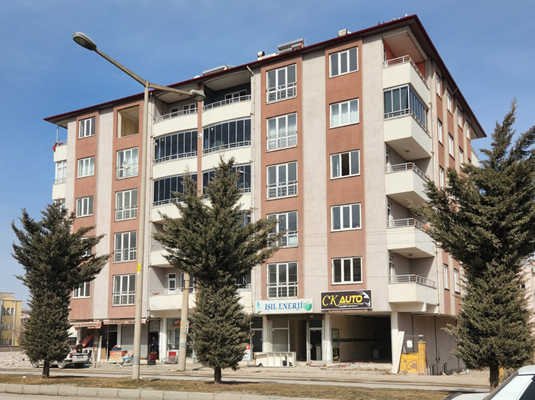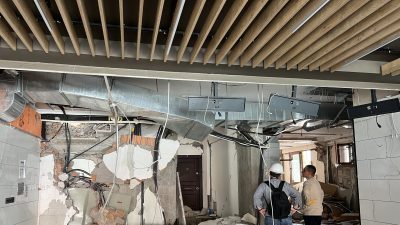March 1, 2023 – Day 2, Team 1
Most of our day was spent in Elbistan, a city near the epicenter of the second earthquake on February 6th, 2023. To get there, we drove through the Kahramanmaraş region, where collapsed and damaged buildings could be seen everywhere. Seeing the severity of damaged buildings across all the cities and the perpetual haze from the concrete dust was disheartening. We planned to investigate the extensive damage observed in the Kahramanmaraş region in the coming days.

Haze from concrete dust against the mountain backdrop
When we arrived in Elbistan, we visited a hospital that performed exceptionally well. The hospital was built five years ago with base isolation because of an ordinance by the Ministry of Health that mandates that all new public hospitals in Turkey be base-isolated. There was minor architectural damage and no observed structural damage. Nonstructural components also seemed to perform well.

Operational base-isolated hospital on the outskirts of Elbistan with only minor nonstructural damage observed
Once we were in the central part of the city, it felt like we were in a war zone. Many buildings had collapsed or sustained severe damage and would need to be torn down. The buildings all seemed to be of similar construction—with rectangular-shaped concrete columns and beams—which looked stronger than the columns in many cases, particularly when framed to the weak direction of the columns. Older buildings used smooth rebar with little to no confinement. Confinement was present in newer buildings and consisted of #3 deformed rebar with 90-degree hooks at the ends. For the typical columns with high aspect ratios, only one hoop was typically observed around the entire column.

Exposed smooth rebar in slab at collapsed building
Nearly all the buildings we observed were composed mostly of windows and doors on the first floor and more solid infill panels on the stories above. In addition, the upper levels usually cantilevered out over the first story so the builders could create more space within the building footprint and still meet the setback requirements on the first floor and sidewalks. This caused a soft/weak story effect, where the damage concentrated at the flexible first floor while the upper stories moved as a rigid block, the first story failed, and the rest of the building came crashing down.

Typical construction at undamaged building: open storefront at first story, residential units above with masonry infill

Collapsed soft-story with concrete frame and masonry infill exposed

Building with severe structural and non-structural damage at the first story

Close-up of structural column damage
We stopped in the town of Golbasi on our way back from Elbistan. From the road, we saw a building that had experienced some foundation failure, likely liquefaction, which fell over into the adjacent buildings. It was surreal to see that the structure and its foundations were fine and appeared to have minimal damage outside a couple of infills, despite the building leaning over 45 degrees.

Kim Bocanegra (left), Rafael Alaluf (middle), and Jose Flores Ruiz (right) observe a building foundation failure

Damage to sidewalk pavement due to soil liquefaction
At our last stop in Pazarcik, the damage was widespread, with numerous collapsed buildings and various teams working on clearing their construction debris. Pazarcik has more mid-height buildings at around 8- to 10-stories tall. For the most part, these buildings structurally performed at a life safety or collapse prevention level, but often had severe damage to nonstructural components such as the infill walls. The town focused heavily on removing the debris, but some stores were already opened—and food and water were available for sale. There were also international organizations offering resources like food and water to the local community.

Members of Team 1 near a pile of debris from a collapsed building
Stay tuned for more daily blogs from the two earthquake reconnaissance teams assembled by Degenkolb.



